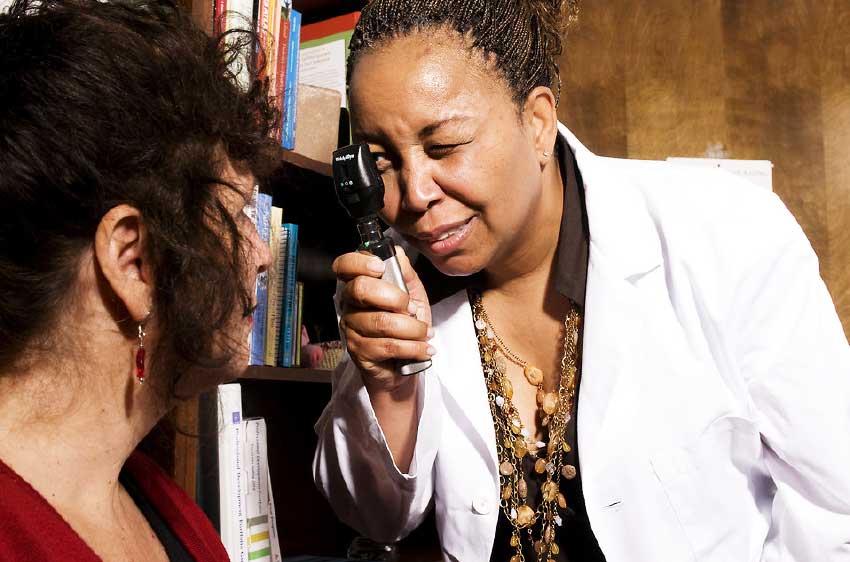HAPPY 40TH ANNIVERSARY ST. LUCIA! May you continue to be blessed and productive, and to enjoy good health especially eye health!
A number of studies indicate that sight is the sense that people worry about losing most, but in the hustle and bustle of life, we sometimes take our vision for granted. In the first three decades of life, those of us with visual problems can usually correct them by wearing corrective lenses – glasses or contact lenses. However, in the early to mid – forties, we (even those of us who have enjoyed perfect eyesight so far or who wear glasses), begin to notice visual changes, the principal complaint being difficulty in seeing when reading or doing close work like texting or using our computer. But there is no need for panic – this condition known as Presbyopia – is a perfectly normal change in our eyes as we age and does not signify any sort of disease process. The onset of presbyopia is often a significant and emotional event because it is a sign of aging that is impossible to ignore and difficult to hide.

PRESBYOPIA – Cause, Symptoms and Signs:
Presbyopia is caused by an age-related process. This differs from astigmatism, near- sightedness and far- sightedness which are related to the shape of the eye ball and are associated with genetic and environmental factors.
Presbyopia is generally believed to stem from a gradual thickening and loss of flexibility of the natural lens inside your eyes due to changes in the proteins of the lens. The muscle fibres surrounding the eye also lose elasticity making it more difficult to focus on close objects.
When you become presbyopic you have to hold your smartphone, other objects and reading material (books, bills, menus, labels etc.) further away from your eyes in order to see them more clearly. Unfortunately, when you move things further away from your eyes, they appear smaller in size, so this is only a temporary and partially successful solution to the problem.
Presbyopia can cause headaches, eye strain and visual fatigue that make reading and other near vision tasks less comfortable and more taxing.
Treatment of Presbyopia:
A summary of the available options includes:
• Eyeglasses with either bifocal or progressive lenses
• Reading glasses – worn only when needed for close tasks
• Multifocal or monofocal contact lenses. Your doctor can also prescribe reading glasses to be worn over your normal contact lenses.
• Surgery – There are a number of options including:
PresbyLasix/Monovision Lasix/Nearvision Lasix
Refractive Lens exchange
Corneal Inlay/Karma Inlay
The first step for the surgical option is to find out whether you are a good candidate for the surgery by consulting a refractive surgeon who has specialized in this form of surgery.
OTHER AGE-RELATED VISION CHANGES
In addition to Presbyopia you may notice other changes in your vision as you age. These include:
A need for more light especially when doing close work.
Increased sensitivity to glare
Changes in colour perception
Reduced tear production in which case your eyes feel dry and irritated.
WARNING SIGNS OF EYE HEALTH PROBLEMS:
As you age you may also experience the following which may indicate a significant eye health problem:
• Fluctuating vision – may be a sign of Diabetes or Hypertension
• Seeing floaters or flashes – these are bothersome but don’t typically harm vision. If they persist you should consult your ophthalmologist.
• Loss of side vision – may indicate Glaucoma
• Seeing distorted images (straight lines appear distorted) – may be related to Age Related Macular Degeneration.
SUMMARY:
Generally, changes in your eyes at 40 are a normal factor of aging. However, some of the changes may be early signs of eye health problems.
A regular eye exam is the best way to protect your sight. It is particularly important if you notice a change in your vision or if your eye is injured in any way or if you have a family history of eye diseases. In your 40’s and 50’s you should have an eye exam at least every two years or as recommended by your eye doctor. Remember too that problems could develop without any signs or symptoms.
Besides, a comprehensive examination of your eyes – “the most important square inch of your body” – can tell you not only about the health of your eyes but can be a window to your overall health. Illnesses such as diabetes, high blood pressure, autoimmune diseases, sexually transmitted diseases and cancer can be detected during a comprehensive eye examination.











